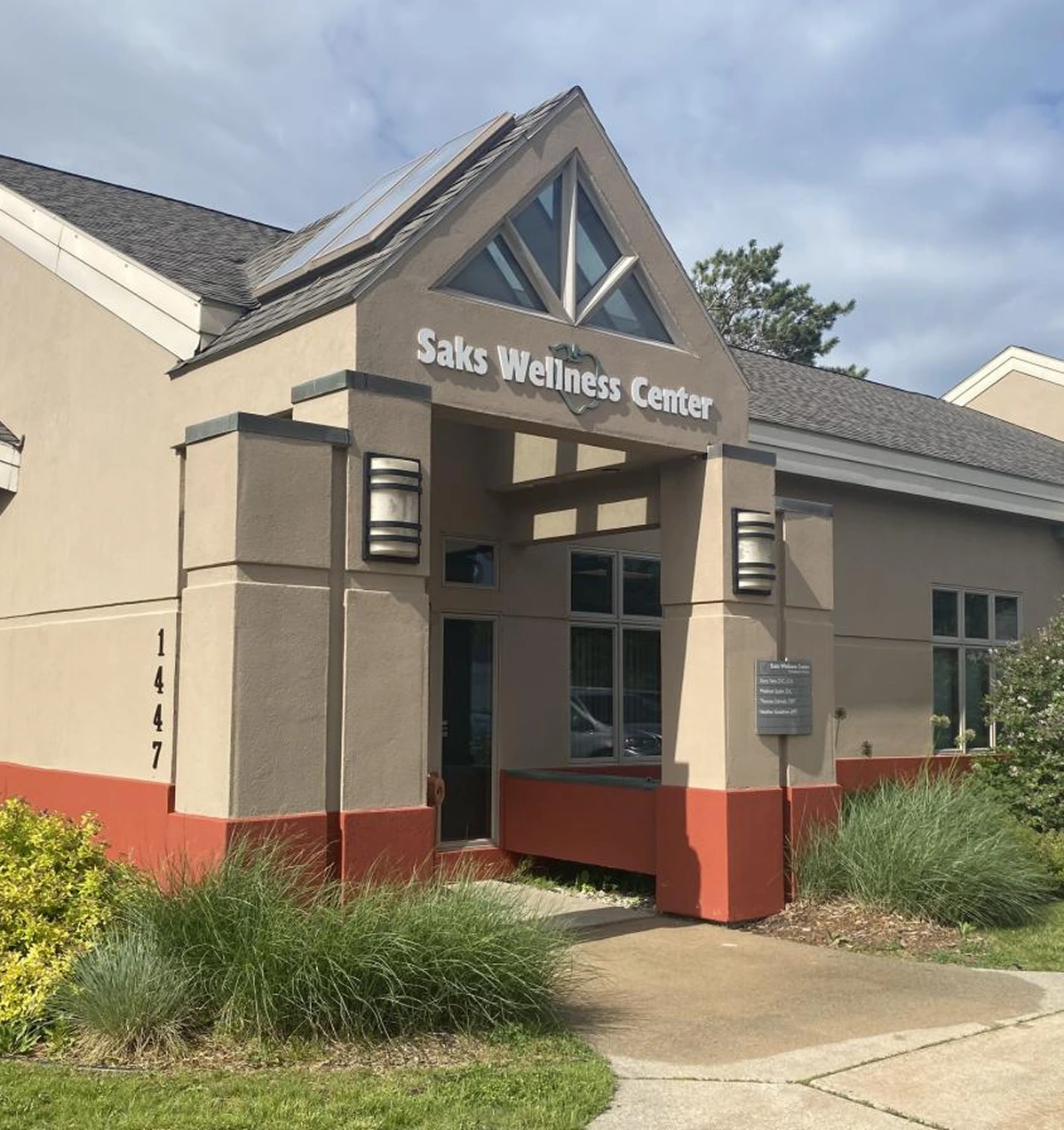Spinal Decompression in Gaylord, MI
Saks Wellness Center in Gaylord, MI, offers spinal decompression as part of our comprehensive approach to spinal health. We combine advanced technology with a deep understanding of individual needs to support spinal alignment and function. Our treatments are designed with precision, allowing for careful adjustments that respect the body’s natural biomechanics.

What Is Spinal Decompression?
Spinal decompression is a non-surgical therapy that relieves pressure on the spinal discs and surrounding nerves. It involves gently stretching the spine using a motorized table or similar device to change its alignment. This process helps reduce compression in targeted spine areas, alleviating pain and other symptoms. The treatment is typically part of a series of sessions tailored to the patient’s condition. Each session usually lasts about 30 to 45 minutes.
Conditions Treated With Spinal Decompression
Lower Back Pain
Spinal decompression therapy is often used to address chronic lower back pain, especially when the discomfort radiates into the legs. This type of pain is commonly linked to compressed spinal discs or pinched nerves in the lumbar region. By gently stretching the spine, decompression can reduce pressure on the discs and nerves, easing pain and stiffness. Many individuals with sciatica or discomfort that travels down the legs find this therapy helpful as part of their care plan. The treatment is typically performed over multiple sessions to promote long-term relief.
Neck Pain
Herniated Discs
A herniated disc occurs when the soft center of a spinal disc pushes through a crack in the tougher exterior casing. This condition often results in localized pain, numbness, or weakness, depending on the location of the herniation. Spinal decompression can create negative pressure within the disc, encouraging the herniated material to retract and relieving nerve irritation.
Degenerative Disc Disease
Degenerative disc disease involves the gradual breakdown of spinal discs, leading to inflammation, instability, and damaged tissue within the spine. As discs lose hydration and height with age or wear, they can compress surrounding nerves and reduce flexibility. Spinal decompression works by gently stretching the spine, which may relieve pressure on the affected discs and help restore space between the vertebrae. This process can reduce strain on the damaged tissue and potentially slow the progression of the condition.
Spinal Stenosis
Spinal stenosis is a condition where the spaces within the spine narrow, placing pressure on the spinal cord and nerves. This narrowing often results in pain, numbness, or weakness, particularly in the back, neck, or limbs. Spinal decompression therapy aims to alleviate this pressure by creating more room in the spinal canal. The treatment may reduce nerve compression and improve circulation in the affected area by gently stretching the spine.

Initial Consultation
During the initial consultation, new patients meet with our provider to discuss their symptoms, medical history, and overall body condition. This first appointment is an opportunity to perform a physical assessment and determine whether spinal decompression is an appropriate treatment option. Our provider will explain how the therapy works and what to expect throughout the process. Questions are encouraged to ensure the patient feels informed and comfortable moving forward. A personalized treatment plan may also be outlined based on the individual’s needs.

Book your personalized consultation with us and let’s explore how we can support your goals
Spinal Decompression Procedure
Preparation
Before the spinal decompression procedure begins, patients are positioned comfortably on a specialized decompression table. The body is carefully secured to allow controlled spine movement during treatment. The therapy is tailored based on the patient’s spinal condition, symptoms, and overall physical structure, ensuring safe and effective pressure relief along the spine.
Treatment Application
Monitoring

Recovery After Spinal Decompression
Recovery after spinal decompression is generally smooth since the procedure is non-surgical and minimally disruptive to the body. Most patients can walk immediately after each session and resume their daily activities without delay. While some individuals may need to wait between sessions to allow the spine to adjust, no extended downtime is typically required. Supporting spinal function through light exercise, hydration, and proper posture is often recommended during the treatment period. Over time, the spine may gradually stabilize as decompression therapy helps relieve pressure and promote improved movement.
Candidates for Spinal Decompression
Spinal decompression is used as a non-surgical treatment approach for individuals experiencing specific spine-related symptoms. Candidates are typically those who have not found relief through conservative methods and seek a non-invasive alternative to manage their condition.
- Chronic lower back pain or neck pain
- Herniated or bulging discs
- Degenerative disc disease
- Sciatica or radiating leg pain
- Spinal stenosis
- Limited function due to disc-related issues

Benefits of Non-Surgical Spinal Decompression
Pain Management
One of the primary benefits of non-surgical spinal decompression is the significant reduction of pain associated with various spinal conditions. By alleviating pressure on nerves and reducing inflammation, patients often experience relief from chronic pain that may have been persistent for an extended period.
Improved Disc Health
A unique feature of non-surgical spinal decompression is that it actually promotes better disc health by enhancing nutrient and oxygen exchange within the intervertebral discs. This increased circulation aids in the healing of damaged discs and facilitates the retraction of herniated or bulging disc material.
Non-Invasive Nature
Unlike surgical procedures, non-surgical spinal decompression does not involve incisions, anesthesia, medications, or a prolonged recovery period. This non-invasive approach makes it an attractive option for individuals looking to address their spinal issues without the associated risks and downtime of surgery.
Increased Mobility
By reducing pressure on the spine and addressing underlying issues, non-surgical spinal decompression can improve mobility. This can be particularly beneficial for individuals with conditions such as degenerative disc disease or spinal stenosis, helping them regain a more active and pain-free lifestyle.
Customized Treatment Plans
Non-surgical spinal decompression is often tailored to the specific needs of each patient. Our healthcare professionals can adjust the treatment parameters, such as the amount of pressure and the duration of sessions, to address individual conditions and ensure optimal outcomes.
Minimal Side Effects
Especially when compared to medications or invasive procedures, non-surgical spinal decompression has minimal side effects. Patients may experience mild soreness or discomfort initially, but this is usually temporary and diminishes as the treatment progresses.
Non-surgical spinal decompression offers a ray of hope for individuals burdened by chronic back or neck pain and other spinal conditions. With its focus on natural healing and minimal invasiveness, this therapy has proven to be a valuable alternative to more traditional approaches. Consult our doctors to determine its suitability for your specific condition. Your road to a healthier, pain-free spine may be paved with non-surgical spinal decompression.
Cost of Spinal Decompression in Gaylord, MI
The cost of spinal decompression in Gaylord, MI, ranges from $50 to $150 per session, depending on the provider and the length of the treatment plan. Pricing may vary based on the severity of symptoms, the number of sessions recommended, and whether additional therapies are included. For accurate pricing and to learn what is included in each session, call our office to speak with our provider. They can provide details tailored to your specific needs and treatment goals.

Saks Wellness Center Is a Top Destination for Spinal Decompression
Saks Wellness Center isn’t just a regular medical facility—it’s a place where the local community comes for the latest treatments and long-term support. Spinal decompression is more than a service; it’s part of a broader philosophy rooted in careful attention, ongoing learning, and respect for the body’s natural healing.
Dr. Saks, Dr. Saylor, and Dr. Freeman listen carefully to each patient’s needs, tailor treatments, and bring decades of combined expertise to every session. The result is care delivered by knowledgeable providers, supported by a team of professionals who make every interaction feel personal, purposeful, and part of something larger than just services—our specialists are here to serve the whole person, not just the spine.
Frequently Asked Questions
Is spinal decompression considered a neuropathy treatment?
Spinal decompression can help relieve nerve pressure caused by spinal injury, which may contribute to neuropathy symptoms. Thus, it can be classified as a neuropathy treatment in many cases.
Can spinal decompression help patients with bulging discs?
Does chiropractic care provide long-term pain relief?
Our chiropractors apply their expertise to create personalized care plans, provide long-term pain relief, and improve spinal function.
Can I combine spinal decompression with laser therapy?
Yes, spinal decompression can be safely combined with laser therapy to enhance overall treatment effectiveness.
Frequently Asked Questions
Is spinal decompression
considered a neuropathy
treatment?
considered a neuropathy
treatment?
Spinal decompression can help relieve nerve pressure caused by spinal injury, which may contribute to neuropathy symptoms. Thus, it can be classified as a neuropathy treatment in many cases.
Can spinal decompression
help patients with bulging
discs?
help patients with bulging
discs?
Does chiropractic care
provide long-term pain
relief?
provide long-term pain
relief?
Our chiropractors apply their expertise to create personalized care plans, provide long-term pain relief, and improve spinal function.
Can I combine spinal
decompression with laser
therapy?
decompression with laser
therapy?
Yes, spinal decompression can be safely combined with laser therapy to enhance overall treatment effectiveness.

